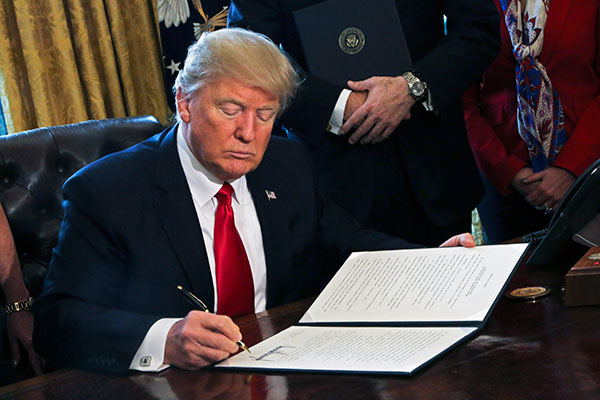
Trump’s new order will roll back many environmental
regulations put in place by the Obama administration
Trump flouts green concerns; lifts freeze on coal
WASHINGTON, March 29, 2017
US President Donald Trump’s latest executive order will mean some swift changes in areas such as lifting the coal moratorium, no longer factoring in climate change in environmental reviews, and changing the social cost of carbon, a report said.
On March 28, Trump signed an executive order that looks to promote domestic production of oil, natural gas, coal, and nuclear production by rolling back certain environmental regulations, explained Barclays, a London-based multinational banking and financial services company, in a new analysis.
The order is expected to force federal agencies to identify specific actions that could cause unneeded regulatory burden and that are preventing higher production of energy resources.
On the margin, the executive order should be viewed as more bullish for coal and more bearish for competing generation types in the power sector such as natural gas, renewables and nuclear, according to Barclays.
The executive order focuses on these main areas:
- Undoing of the Clean Power Plan (CPP): Expect this to be held up in court for the foreseeable future (bullish coal, bearish natural gas renewables, nuclear)
- Lifting the moratorium on new coal leases on federal lands: Can be changed immediately by executive order (bearish coal, natural gas)
- No longer factor climate change into environmental reviews: Can be changed immediately by executive order (bullish coal, bearish natural gas, renewables, nuclear)
- Change the social cost of carbon for cost benefit analysis: Can be changed immediately by executive order (bullish coal, bearish natural gas, renewables, nuclear)
- Rescind rule that sets standards for hydraulic fracturing on public lands: Expect further legal challenges (bearish natural gas, oil)
- Initiate review on efforts to reduce methane emissions: Review can be conducted immediately - eventual results likely to be challenged in court (bearish natural gas, oil)
“Besides optics, we do not see these areas as having an immediate effect on the market. Given the significant difficulties the US coal industry has faced, companies are unlikely to look to expand their reserves, even with the coal moratorium lifted,” Barclays said in the analysis.
“Not factoring in climate change to planning and changing the cost of capital, will serve Trump's broader goal of lessening regulation in the energy sector but are unlikely to have immediate market effect. Previously, the social cost of carbon has pegged at $40 per ton of CO2 and has been used to conduct cost benefit analysis of new policy decisions.”
Expect more challenges on CPP and fracking
The CPP is probably the highest profile piece that will be affected by Trump’s executive order. Yet, coal’s story is twofold. First, the order will do little to bring back jobs to Appalachia, given the high level of pollutants and its economics relative to Powder River Basin (western coal), and second, coal’s demise has been market not policy related (low natural gas prices).
After the order the Trump administration will ask the DC circuit Court of Appeals, which is currently hearing the case, to not rule on the matter which will give Trump and the EPA time to undo the measure.
The process is likely to be a lengthy one as any new rule will have to go through a formal rule making process at the EPA which can take up to one year. Additionally, the same way the CPP has been challenged in court by 28 states, an attempt to dismantle the CPP will be met with lawsuits from environmental groups and potentially even some states. All of this means that we could see a very long process before anything is truly decided on the fate of the CPP.
Of the 28 per cent reduction in GHG emissions by 2025, 60-65 per cent of that reduction would have come from the implementation of the Clean Power Plan.
The dismantling of Obama era decarbonisation initiatives allows Trump to pull away from commitments that were part of the US government’s commitment to the Paris accords without fully pulling out of the process.
The US commitment entails a 17 per cent reduction in emissions by 2020 from 2005 levels and 26-28 per cent lower than the 2005 levels by 2025. Items on the commitment list include the Clean Power Plan, heavy duty vehicle fuel standards, landfill methane emissions standards, and building sector emissions standards.
Despite the executive order, states can still decide the direction they will take. Immediately following Trump’s announcement, California and New York reaffirmed their commitment to exceeding CPP targets. – TradeArabia News Service







